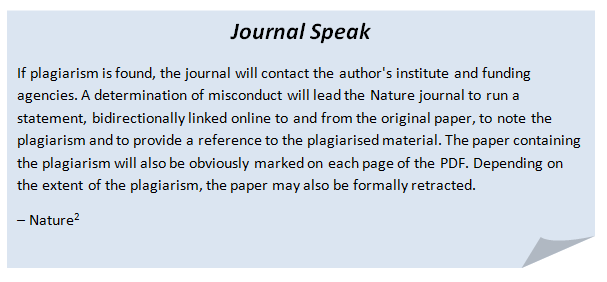Plagiarism in academic publishing
Plagiarism
Plagiarism is the most common form of academic misconduct and can lead to outright rejection. Often, authors accidentally commit plagiarism without even realizing it. This series aims to make authors aware of the different forms of plagiarism, the precautions to be taken to avoid them, and ways to defend themselves from false allegations of plagiarism.

When undertaking a research project, researchers often find that others have developed similar ideas. There may be others who have devised an investigative technique, who have described the natural history of a disease or the structure of a compound, or explained some processes in such an elegant way that their description cannot be bettered and the researcher decides to use it verbatim.
It is extremely important to remember, when writing a paper, to acknowledge all such sources clearly and completely. Attempting to use the ideas, words, or work done earlier by another person, without giving them due credit, is considered extremely unethical and is termed plagiarism.
Types of plagiarism
Deliberate plagiarism occurs when
- The author does not give due credit to previous work done in the field but instead presents the previous work as his or her own idea.
- The author does not credit techniques used to conduct the research to the people who developed them.
- The opinions and ideas of others are passed off as the author’s.
Very often, poor time management or time constraints push a researcher to plagiarize large chunks of material from other authors, instead of spending time on background research and original writing.
Accidental or unwitting plagiarism occurs when
A careless mistake is made when writing down the references.
- The researcher does not feel the need to acknowledge the original author of a well-known fact, considering it “common scientific knowledge” (e.g., global warming is causing climate change).
- There is a cultural difference, for example, junior researchers from certain cultures may feel that it would not be correct to alter the words used by a senior researcher who is an authority in the field.
- There are language problems: nonnative speakers of English may not be confident of their ability to paraphrase another author's words while still retaining the correct meaning.
- The article being paraphrased is a highly technical description, which the researcher feels incapable of writing in his or her own words. This is especially true for students or inexperienced researchers.
Self-plagiarism occurs when
- A person has published some articles earlier and then combines them together to make one larger article or even a book without acknowledging the previous articles.
- The author creates salami publications in an attempt to publish different aspects of the same study as different papers, even if the study would be better presented as one large paper.
How plagiarism is detected
The easiest way to identify plagiarism is when a reviewer or journal editor finds that a submitted manuscript contains large passages quoted verbatim, or with very little modification, from a previously published work. The reviewer's suspicions are raised if
- the writing style varies considerably between passages in the submitted work,
- the level of English used is very different in different parts of the manuscript, or
- the reviewer is familiar with the work that has been plagiarized.
In addition, many journals are now using plagiarism detecting software. For example, over 250 publishers are using Crosscheck (powered by the software iThenticate, including major publishers like Nature Publishing Group, Elsevier, and Wiley-Blackwell. Articles are automatically rejected by journals if Crosscheck returns a positive result for plagiarism.
Tips to avoid accidental plagiarism
In academic writing, it is important to remember that all references to previous work done in the field must be correctly cited. All sources referred to for techniques and background for the study must be comprehensively and correctly referenced.
- If you feel that you would be unable to paraphrase another author’s work adequately, it is permissible to quote the author’s work verbatim. However, you have to enclose these sentences in quotation marks.
- Quotation marks are not required when you paraphrase or summarize another author, but you have to make sure that you have really rewritten the paragraph in your own words while retaining the original meaning. Just changing a few words here and there in the original paragraph is still considered as plagiarism.
- When taking notes, write down material from other studies in your own words. Make sure you add quotation marks to any text you have copied from the source, so that you can identify any material you’ve directly copied when referring to your notes later on.
- Even if you are not confident that you can adequately paraphrase another author’s words, try your best. Ask a co-author or colleague to help you, or use professional editing services to polish the language.
- Even when assuming that the facts or technique you are referring to is “common scientific knowledge,” it is always better to give a reference to the original author. Some readers of a broad based journal may not be experts in your subject area and would welcome the information.

Researchers found to plagiarize others works could lose tenure/funding and, more importantly, lose credibility in the academic community for his or her entire body of work. No one is spared if plagiarism is detected, as is evident from the story of the German defense minister who had to resign from his position and give up his doctorate after his doctoral dissertation was found to contain plagiarized passages.3
Another comprehensive site on plagiarism, by Miguel Roig for the Office of Research Integrity1, gives excellent examples of plagiarism in academia. A few of them are quoted below:
- A biochemist resigned from a prestigious clinic after he was accused of taking text from a National Academy of Sciences report and adding it to his book.
- A college president was forced to resign after allegations that he failed to attribute the source of material that was part of a college convocation speech.
- A psychologist had his doctoral degree rescinded after the university found out that portions of his doctoral dissertation had been plagiarized.
Conclusion
Attempting to pass off someone else's work, words, or ideas as your own is extremely unethical. An accusation of plagiarism can, at best, leave the researcher with a reputation for sloppy and careless work. At worst, such an accusation can taint the researcher forever, with a reputation for indulging in scientific fraud. Careful attention to detail when quoting, appropriate paraphrasing, and meticulous acknowledgement of sources will help researchers avoid accusations of plagiarism.
Related reading:
You may also be interested in reading this:
References
- Roig M (2006). Avoiding plagiarism, self-plagiarism, and other questionable writing practices: A guide to ethical writing. Available at: https://ori.hhs.gov/avoiding-plagiarism-self-plagiarism-and-other-questi.... Last accessed: December 28, 2011.
- Nature. Plagiarism and fabrication. Editorial policies: Publication ethics. Last accessed on October 19, 2011. Available from: http://www.nature.com/authors/policies/plagiarism.html
- Boston W. Germany: Plagiarism Claims Take Down Guttenberg. Time World. March 3, 2011.
Published on: Oct 17, 2013
Comments
You're looking to give wings to your academic career and publication journey. We like that!
Why don't we give you complete access! Create a free account and get unlimited access to all resources & a vibrant researcher community.

Subscribe to Manuscript Writing



















